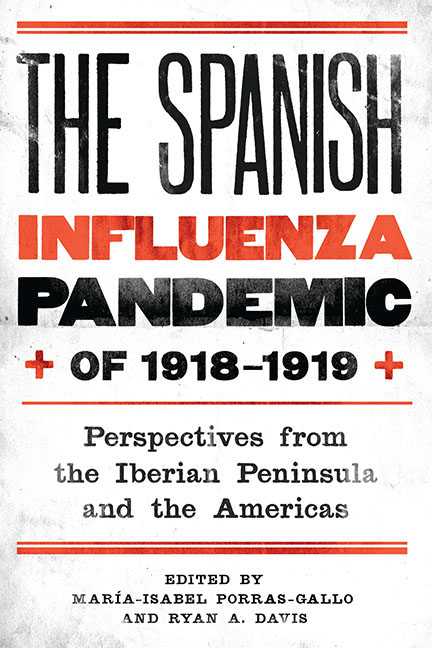 The Spanish Influenza Pandemic of 1918–1919
The Spanish Influenza Pandemic of 1918–1919 Book contents
- Frontmatter
- Dedication
- Contents
- Introduction: Emerging Perspectives of the Spanish Influenza Pandemic of 1918–19
- Part One Scientific Discourse: Now and Then
- Part Two Social Responses: Human and Institutional Actors
- Part Three Interpreting the Epidemic: Sociocultural Dynamics and Perspectives
- 9 A Tale of Two Spains: Narrating the Nation during the 1918–19 Influenza Epidemic
- 10 The Spanish Flu in Argentina: An Alarming Hostage
- 11 Epidemic Disease, Local Government, and Social Control: The Example of the City of Alicante, Spain
- 12 The Gendered Dimensions of Epidemic Disease: Influenza in Montreal, Canada, 1918–20
- 13 Remembering and Reconstructing: Fictions of the 1918–19 Influenza Pandemic
- Selected Bibliography
- List of Contributors
- Index
12 - The Gendered Dimensions of Epidemic Disease: Influenza in Montreal, Canada, 1918–20
from Part Three - Interpreting the Epidemic: Sociocultural Dynamics and Perspectives
Published online by Cambridge University Press: 14 March 2018
- Frontmatter
- Dedication
- Contents
- Introduction: Emerging Perspectives of the Spanish Influenza Pandemic of 1918–19
- Part One Scientific Discourse: Now and Then
- Part Two Social Responses: Human and Institutional Actors
- Part Three Interpreting the Epidemic: Sociocultural Dynamics and Perspectives
- 9 A Tale of Two Spains: Narrating the Nation during the 1918–19 Influenza Epidemic
- 10 The Spanish Flu in Argentina: An Alarming Hostage
- 11 Epidemic Disease, Local Government, and Social Control: The Example of the City of Alicante, Spain
- 12 The Gendered Dimensions of Epidemic Disease: Influenza in Montreal, Canada, 1918–20
- 13 Remembering and Reconstructing: Fictions of the 1918–19 Influenza Pandemic
- Selected Bibliography
- List of Contributors
- Index
Summary
In recent years, a number of social historians of medicine have begun to apply the insights of gender history to their studies of health and illness. This chapter builds on such work by examining the influenza pandemic of 1918–20 through a gendered lens, revealing the ways in which the epidemic reaffirmed (and, very occasionally, altered) the roles and responsibilities assigned to men and women respectively in Montreal, Canada's early twentieth- century metropolis.
On the surface, the Montreal epidemic might appear to have been gender-neutral. Historians of other places have pointed out that, globally, more men than women died of influenza during the 1918–20 pandemic and suggest that this disparity was caused by the larger numbers of men present in the public sphere—as paid workers and as active members of the armed forces during the Great War—and thus at greater risk than women of exposure to the virus. In Montreal, by contrast, men and women died in roughly equal numbers during these epidemics—perhaps because, in a metropolis such as Montreal, built in part on so-called light industry, unmarried women participated in paid labor in large numbers and were thus also at risk of contracting the virus. Montreal women were also exposed to the virus because, as we shall see, they were the primary caregivers during the epidemic—although this was surely the case elsewhere as well. Nonetheless, despite mortality rates that differed little by sex, this epidemic, like others, had gendered dimensions and implications. The management of the epidemic drew on, and benefited from, well-established gendered roles and divisions of labor in Montreal. Moreover, the campaigns waged against influenza in 1918–20 both valorized and ultimately reinforced the gendered nature of such roles and responsibilities. This chapter begins by interrogating the gendered dimensions of caregiving during the epidemic. It then examines the obituaries of doctors, priests, and nuns felled by influenza and highlights the gendered qualities attributed to these caregivers who lost their lives during the epidemic. Finally, it explores some of the public health solutions proposed in the immediate wake of the epidemic and underlines the ways in which the suggestions of female middle-class reformers drew on women's particular experiences of the epidemic and differed slightly from those of medical, municipal, and religious authorities.
- Type
- Chapter
- Information
- The Spanish Influenza Pandemic of 1918–1919Perspectives from the Iberian Peninsula and the Americas, pp. 230 - 247Publisher: Boydell & BrewerPrint publication year: 2014
